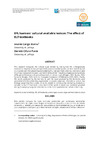Please use this identifier to cite or link to this item:
https://accedacris.ulpgc.es/jspui/handle/10553/70355
| Title: | EFL learners’ cultural available lexicon: The effect of ELT textbooks | Authors: | Canga Alonso, Andrés Cifone Ponte, Daniela |
UNESCO Clasification: | 570107 Lengua y literatura 550510 Filología |
Keywords: | Lexical availability EFL ELT textbooks Cultural types Source, et al |
Issue Date: | 2016 | Journal: | LFE. Revista de Lenguas para Fines Específicos | Abstract: | This research compares the cultural types elicited by twenty-nine EFL undergraduate students in response to two prompts from a lexical availability task (i.e. food and drink and countryside) and the cultural input provided by four last year High School ELT textbooks used in La Rioja. Cultural words were classified in terms of their frequency of appearance by means of Range and listed according to a framework of cultural topics (Risager, 1991; Byram, 1993;
Byram & Morgan, 1994; Common European Framework of Reference (CEFR, 2001). Finally, the words produced by the learners as well the input provided by the textbooks were associated with the culture they represented i.e. source, target and international culture. Our findings reveal that the number of words related to culture either elicited by students or included in the ELT textbooks is low. Most of the words students and textbooks provided belong to everyday living and international is the most representative culture in the study. Este estudio compara los tipos culturales producidos por veintinueve estudiantes universitarios de inglés como lengua extranjera en respuesta a dos centros de interés (alimentos y bebidas y el campo) de una prueba de disponibilidad léxica y el vocabulario cultural proporcionado por cuatro libros de texto de inglés utilizados en 2º de Bachillerato en La Rioja. Las palabras obtenidas se clasificaron en función de su frecuencia por medio de la aplicación Range y se catalogaron de acuerdo con el modelo de temas culturales (Risager, 1991; Byram, 1993; Byram & Morgan, 1994; Marco Común Europeo de Referencia (MCER, 2001). Por último, las palabras producidas por los alumnos, así como las proporcionadas por los libros fueron relacionadas con la cultura que representan es decir, cultura origen, meta e internacional. Nuestros resultados revelan que el número de palabras culturales, bien producidas por los estudiantes o incluidas en los libros de texto para la enseñanza del inglés es bajo. La mayoría de las palabras producidas por los participantes e incluidas en los materiales analizados pertenecen a la vida cotidiana, siendo la cultura internacional la que se encuentra más representada en el estudio. |
URI: | https://accedacris.ulpgc.es/handle/10553/70355 | ISSN: | 1133-1127 | DOI: | 10.20420/rlfe.2016.117 | Source: | LFE. Revista de lenguas para fines específicos [eISSN 2340-8561], v. 22 (2), p. 177-201 |
| Appears in Collections: | Artículos |
WEB OF SCIENCETM
Citations
3
checked on Jun 8, 2025
Page view(s)
86
checked on Apr 13, 2024
Download(s)
76
checked on Apr 13, 2024
Google ScholarTM
Check
Altmetric
Share
Export metadata
Items in accedaCRIS are protected by copyright, with all rights reserved, unless otherwise indicated.
